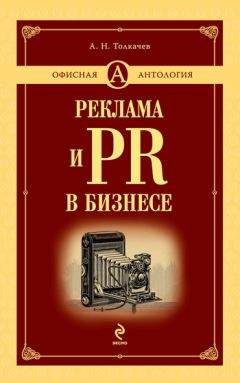Ричард Харрис - Психология массовых коммуникаций

Скачивание начинается... Если скачивание не началось автоматически, пожалуйста нажмите на эту ссылку.
Жалоба
Напишите нам, и мы в срочном порядке примем меры.
Описание книги "Психология массовых коммуникаций"
Описание и краткое содержание "Психология массовых коммуникаций" читать бесплатно онлайн.
«Предупреждён – значит вооружён». Такой эпиграф мог бы открывать эту книгу. И не имеет значения, кто возьмёт её в руки. Специалист почерпнёт в ней новые приёмы и подходы к анализу стратегии и тактики СМИ. Любознательный обыватель научится обеспечивать собственную информационную безопасность.
Кроме того картина информационного ландшафта современного общества от предвыборного управления массовым сознанием до рекламы памперсов оказывается настолько захватывающей, что однажды начав читать эту книгу, вы уже не оставите её недочитанной.
Singhal, A., Rogers, E. M. (I989b). Entertainment-education strategies for family planning. Populi, 16(2), 38–47.
Singhal, A., Rogers, E. M. (1989 c). India's information revolution. New Delhi: Sage.
Sintchak. G., Geer, J. (1975). A vaginal plethysmograph system. Psychophysiology, 12. 113–115.
Skill. T., (1994). Family images and family actions as presented in the media: Where we've been and what we've found. In: D. Zillmann, J. Bryant. and A. Huston (Eds.). Media, children, and the family: Social scientific, psychodynamic, and clinical perspectives (p. 37–50) Hillsdale. NJ: Lawrence Eribaum Associates.
Skill. T., Lyons, J. S., Larson, D. (1991, November). Television and religion: Content analysis of the portrayal of spirituality in network prime time fictional programs. Summary report to the American Family Association, Tupelo, MS.
Skill. T., Robinson, J., Wallace, S. (1987). Family life on prime time television: Structure, type, and frequency. Journalism Quarterly. 64(2/3), 360–367, 398.
Skill. Т ., Wallace. S. (1990). Family interactions on prime time television: A descriptive analysis of assertive power interactions. Journal of Broadcasting and Electronic Media, 344(3). 243–262.
Skill. T., Wallace, S., Cassata, M. (1990). Families on prime time television: Patterns of conflict escalation and resolution across intact, no intact, and mixed-family settings. In: J. Bryant (Ed.). Television and the American family (p. 129–163). Hillsdale, NJ: Lawrence Eribaum Associates.
Slater. D., Elliott, W. R. (1982). Television's influence on social reality. Quarterly Journal of Speech, 68, 69–79.
Slater. M. D. (1990). Processing social information in messages: Social group familiarity, fiction versus non-fiction, and subsequent beliefs. Communication Research. 17, 327–343.
Smith. R., Anderson, D. R., Fischer, C. (1985). Young children's comprehension of montage. Child Development, 56, 962–971.
Snyder, L., Roser. C., Chaffce, S. (1991). Foreign media and the desire to emigrate from Belize. Journal of Communication, 4/(1), 117–132. Soap operas. (1981. September 28). Newsweek, 65.
Soley, L. (1983). The effect of black models on magazine ad readership. Journalism Quarterly, 60(4), 686–690.
Solomon, D. S., Cardillo, B. A. (1985). The elements and process of communication campaigns. In: T. A. van Dijk (Ed.). Discourse and communication (p. 60–68). Berlin: dcGruyter.
Sommers-Flanagan, R., Sommers-Flanagan, J., Davis, B. (1993) What's happening on Music Television? Sex Roles, 28, 745–753.
Spangler, L. C. (1989). A historical overview of female friendships in prime time television. Journal of Popular Culture, 22(4). 13–23.
Spangler, L. C. (1992). Buddies and pals: A history of male friendships on prime time television. In: S. Craig (Ed.). Men, masculinity, and the media (p. 93–110). Newbury Park, CA: Sage.
Sparks, G. G. (1986). Developmental differences in children's reports of fear induced by the mass media. Child Study Journal, /6(1), 55–66.
Spencer, J. W., Seydlitz, R., Laska. S., Triche, E. (1992). The different influences of newspaper and television news reports of a natural hazard on response behavior. Communication Research, 19, 299–325.
Sprafkin, J. N., Gadow. K. D., Abelman, R. (1992). Television and the exceptional child: A forgotten audience. Hillsdale, NJ: Lawrence Eribaum Associates.
Stall, R. D., Coates, T. J., Hoff, C. (1988). Behavioral risk reduction for H1V infection among gay and bisexual men. American Psychologist, 43, 878–885.
Stayman, D. M., Kardes, F. R. (1992). Spontaneous inference processes in advertising: Effects of need for cognition and self-monitoring on inference generation and utilization. 7ourna/o/Consumer Psyc/ip/ogy, /, 125–142.
Stein, B. (1979). The view from Sunset Boulevard. New York: Basic Books.
Stein, B. (1987). Fantasy and culture on television. In: A. A. Berger (Ed.). Television in society (p. 215–228). New Brunswick, NJ: Transaction Books.
Stein, J. (1997 a, September 22). The God squad. Time.
Stein, J. (1997 b. December 15). Tall men behaving badly. Time. 91–92.
Stein, J. (1998. February 2). And they get held up again. Time, 79.
Stempel, G. (1971). Visibility of blacks in news and news-picture magazines. Journalism Quarterly. 48(2), 337–339.
Stephens, N., Stutts, M. A. (1982). Preschoolers' ability to distinguish between television programming and commercials. Journal of Advertising, II, 16–26.
Stern, B. L., Harmon, R. R. (1984). Disclaimers in children's advertising. Journal of Advert/sins. 13, 12–16.
Sternthal, В ., Craig, S. (1973). Humor in advertising. Journal of Marketing, 37(4), 12–18.
Stewart, L. (1988. February 18). For ABC, it's been all downhill in Winter Olympics. Manhattan Mercury. (LA. Times wire)
Stodghill, R. (1998, June 15). Where'd you learn that? Time, 52–59.
Stone, G. (1987). Examining newspapers: What research reveals about America's newspapers. Newbury Park, CA: Sage.
Stonehill, B. (1995, Spring). Hearts, smarts, and sparkle. Los Angeles Times. (Reprinted in Connect, 9, p. 4.)
Stout, D. A., Buddenbaum, J. M. (Eds.). (1996). Religion and mass media: Audiences and adaptations. Thousand Oaks, CA: Sage.
Strasburger, V. C. (1995). Adolescents and the media: Medical and psychological impact. Thousand Oaks, CA: Sage.
Strate, L. (1992). Beer commercials: A manual on masculinity. In: S. Craig (Ed.). Men, masculinity, and the media (p. 78—92). Newbury Park, CA: Sage.
Straubhaar, J. D., Heeler, C., Greenberg, B. S., Ferreira, L., Wicks, R. H., Lau, T.-Y. (1992). What makes news: Western, socialist, and Third-world newscasts compared in eight countries. In: F. Korzenny S. Tmg-Toomey (Eds.). Mass media effects across cultures (p. 89–109). Newbury Park. CA: Sage.
Strobel. W. R (1997). Late-breaking foreign policy: The news media's influence on peace operations. Washington DC: Institute of Peace Press.
Strouse, J. A., Fabes, R. A. (1985). Formal vs. informal sources of sex education: Competing forces in the sexual socialization process. Adolescence, 78, 251–263.
Stutts. M. A., Hunnicutt, G. G. (1987). Can young children understand disclaimers in television commercials Journal of Advertising, /6(I), 41–46.
Stuns. M. A., Vance. D., Hudelson, S. (1981). Program-commercial separators in children's television: Do they help a child tell the difference between Bugs Bunny and The Quik Rabbit? Journal of Advertising, 10(2), 16–48.
Subervi-Velez, F. A., Colsant, S. (1993). The television worlds of Latino children. In: G. L. Berry J. K. Asamen (Eds.). Children television (p. 215–228). Newbury Park, CA: Sage.
Suleiman, M. W. (1988). The Arabs in the mind of America. Brattleboro, VT: Amana Books.
Suls. J. M. (1983). Cognitive processes in humor appreciation. In: P. E. McGhee J. H. Goldstein (Eds.). Handbook of humor research: Basic issues (Vol. I, p. 39–57). New York: Springer-Verlag.
Surlin. S. H. (1974). Bigotry on air and in life: The Archie Bunker case. Public Telecommunications Review, 212, 34–41.
Sutton, S. R. (1982). Fear-arousing communications: A critical examination of theory and research. In: R. Eiscr (Ed.). Social psychology and behavioral medicine (p. 303–337). London: Wiley.
Tamborini, R. (1991). Responding to horror: Determinants of exposure and appeal. In: J. Bryant D. Zillmann (Eds.). Responding to the screen: Reception and reaction processes (p. 305–328). Hillsdale, NJ: Lawrence Eribaum Associates.
Tamborini, R. (1996). A model,of empathy and emotional reactions to horror. In: J. B. Weaver R.
Tamborini (Eds.). Horror films (p. 103–123). Mahwah, NJ: Lawrence Eribaum Associates.
Tamborini, R., Choi, J. (1990). The role of cultural diversity in cultivation research. In: N. Signorielli M. Morgan (Eds.). Cultivation analysis: New directions in media effects research (p. 157–180). Newbury Park, CA: Sage.
Tamborini, R., Stiff, J. (1987). Predictors of horror film attendance and appeal: An analysis of the audience for frightening films. Communication Research, 14, 415–436.
Tamborini, R., Stiff, J., Heidel, C, (1990). Reacting to graphic horror: A model of empathy and emotional behavior. Communication Research, 17, 616–640.
Tamborini, R., Stiff. J., Zillmann, D. (1987). Preference for graphic horror featuring male versus female victimization: Individual differences associated with personality characteristics and past film viewing experiences. Human Communication Research, 13. 529–552.
Tan, A. S. (1986). Social learning of aggression from television. In: J. Bryant D. Zillmann (Eds.). Perspectives on media effects (p. 41–55). Hillsdale, NJ: Lawrence Eribaum Associates.
Tan, A. S., Li, S., Simpson, C. (1986). American TV and social stereotypes of Americans in Taiwan and Mexico. Journalism Quarterly, 63, 809–814.
Tannen, D. (1990). You just don't understand: Women and men in conversation. New York: Ballantine Books.
Tannenbaum, P H. (1971). Emotional arousal as a mediator of communication effects (Technical reports of the Commission on Obscenity and Pornography, Vol. 8). Washington, DC: U. S. Government Printing Office.
Tannenbaum, P H. (1980). Entertainment as vicarious emotional experience. In: P. H. Tannenbaum (Ed.). The entertainment functions of television (p. 107–131). Hillsdale, NJ: Lawrence Eribaum Associates.
Tapper, J. (1995). The ecology of cultivation: A conceptual model for cultivation research. Communication Theory, 5, 36–57.
Tate, E., Surlin, S. (1976). Agreement with opinionated TV characters across culture. Journalism Quarterly, 5X2), 199–203.
Tavris, C. (1986). How to publicize science: A case study. In: J. H. Goldstein (Ed.). Reporting science: The case of aggression (p. 23—32). Hillsdale, NJ: Lawrence Eribaum Associates.
Tavris, C. (1988). Beyond cartoon killings: Comments on two overlooked effects of television. In: S. Oskamp (Ed.). Television as a social issue (p. 189–197). New-bury Park, CA: Sage.
Taylor, C. R., Lee, J. Y, Stern. В . В . (1995). Portrayals of African, Hispanic, and Asian Americans in magazine advertising. American Behavioral Scientist, 38, 608–621.
Taylor, S. (19S2). The availability bias in social perception and interaction. In: D. Kahneman, P Slovic, A. Tversky (Eds.). Judgment under uncertainly: Heuristics and biases (p. 190–200). Cambridge, England: Cambridge University Press.
Teplin, L. A. (1985). The criminality of the mentally ill: A dangerous misconception. American Journal of Psychiatry, 142, 593-599.
Thaler, R (1994). The watchful eye: American justice in the age of the television trial. New York: Praeger. Thomas, S. (1986). Gender and social-class coding in popular photographic erotica. Communication Quarterly, J4(2), 103–114.
Thompson, T. L., Zerbinos, E. (1995). Gender roles in animated cartoons: Has the picture changed in 20 years? Sex Roles, 32, 651–673.
Thorndyke, P. W. (1984). Applications of schema theory in cognitive research. In: J. R. Anderson S. M. Kosslyn (Eds.). Tutorials in learning and memory (p. 167–192). San Francisco: Freeman.
Thorson, E. (1990). Consumer processing of advertising. Current Issues and Research in Advertising. 12, 197–230.
Thorson. E. (1994). Using eyes on screen as a measure of attention to television. In: A. Lang (Ed.). Measuring psychological responses to media (p. 65–84). Hillsdale NJ: Lawrence Eribaum Associates.
Thorson, E., Christ, W. G., Caywood, C. (1991). Selling candidates like lubes of toothpaste: Is the comparison apt? In F. Biocca (Ed.). Television and political advertising, Vol. I: Psychological processes (p. 145–172). Hillsdale, NJ: Lawrence Eribaum Associates.
Tinic, S. (1997). United Colors and untied meanings: Benetton and the commodification of social issues. Journal of Communication, 47(3), 3–25.
Toney, G. T, Weaver, J. B. (1994) Effects of gender and gender role self-perceptions on affective reactions to rock music videos. Sex Roles, 30, 567–583.
Took, K. J., Weiss, D. S. (1994). The relationship between heavy metal and rap music and adolescent turmoil: Real or artifact? Adolescence, 29. 613–621.
Toplin. R. B. (1995). History by Hollywood: The use and abuse of the American past. Urbana: University of Illinois Press.
Tower. R. В ., Singer. D. G., Singer, J. L. (1979). Differential effects of television programming on preschoolers' cognition, imagination, and social play. American Journal of Orlhopsychiatiy, 49, 265–281.
Trenaman, J., McQuail, D. (1961). Television and the political image: A study of the impact of television on the 1959 general election. London: Methuen.
Trevino, L. K.. Webster, J. (1992). Flow in computer-mediated communication: Electronic mail and voice mail evaluation and impacts. Communication Research, 19, 539–573.
Tuchman, G. (1978). Making news: A study in the construction ofreality. New York: Free Press.
Tuchman, G. (1987). Mass media values. In: A. A. Berger (Ed.). Television in society (p. 195–202). New Brunswick, NJ: Transaction Books.
Tuchman, S., Coffin, Т . Е . (1971). The influence of election nights television broadcasts in a close election. Public Opinion Quarterly, J5, 315–326.
Tulloch, J. (1989). Australian television and the representation of AIDS. Australian Journal of Communication, 16, 101–124.
Tulloch, J., Chapman, S. (1992). Experts in crisis: The framing of radio debate about the risk of AIDS to heterosexuals. Discourse and Society, 3, 437–467.
Tulloch, J., Kippax. S., Crawford. J. (1993). Television, sexuality, and AIDS. Sydney, Australia: Alien Unwin.
Tunstall, J. (1977). The media are American. New York: Columbia University Press.
Tversky, A., Kahneman, D. (1973). Availability: A heuristic for judging frequency and probability. Cognitive Psychology, 5, 207–232.
Tversky, A., Kahneman. D. (1974). Judgment under uncertainty: Heuristics and biases. Science. 185, 1124–1131.
TV vs. reality (1998, June II). Kansas State Collegian. p. 7.
Twenty-first century Singapore. (1992, August). World Press Review, p. 45.
Туе , J. В ., Warner, K. E., Glantz. S. A. (1987, Winter). Tobacco advertising and consumption: Evidence of a causal relationship. Journal of Public Health Policy, p. 492–508.
Ume-Nwagbo, E. N. E. (1986). "Cock Crow at Dawn" A Nigerian experiment with television drama in development communication. Gazette, 37(4\ 155–167).
U. S. Commission on Obscenity and Pornography. (1970). The report of the Commission on Obscenity and Pornography. New York: Bantam.
Valente, J. (1997, March 2). Do you believe what newspeople tell you? Parade, 4–6.
Valkenburg, P. M., van der Voort, T. H. A. (1994). Influence of TV on daydreaming and creative imagination: A review of research. Psychological Bulletin, 116, 316–339.
van der Voort, T. H. A. (1986). Television violence: A child's eve view. Amsterdam: North-Holland.
van der Voort, T. H. A., Valkenburg, P. M. (1994). Television's impact on fantasy play: A review of research. Developmental review, 14, 27–51.
Подписывайтесь на наши страницы в социальных сетях.
Будьте в курсе последних книжных новинок, комментируйте, обсуждайте. Мы ждём Вас!
Похожие книги на "Психология массовых коммуникаций"
Книги похожие на "Психология массовых коммуникаций" читать онлайн или скачать бесплатно полные версии.
Мы рекомендуем Вам зарегистрироваться либо войти на сайт под своим именем.
Отзывы о "Ричард Харрис - Психология массовых коммуникаций"
Отзывы читателей о книге "Психология массовых коммуникаций", комментарии и мнения людей о произведении.
























